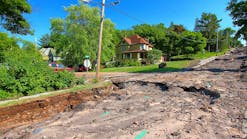In 2013, design work began on Houston’s Lumpkin Road reconstruction project. One phase of the reconstruction required doubling the capacity of an existing L-shaped detention basin to meet the city’s storage needs. Grading for the new pond required construction of more than 22,000 sq ft of retaining walls. Because soils in the area consisted of stiff-to-hard sandy clay and clayey sands down to at least 40 ft below grade, engineers needed a retaining wall that could support the grading for the detention basin while overcoming the challenges posed by the difficult soil conditions.
The city chose Redi-Rock, an engineered retaining wall system that uses 1-ton precast concrete blocks that stack together to create durable walls. Because it can be designed as a gravity wall system without the need for reinforcement, it could be installed in a tight footprint.
Clint Hines, P.E., engineer of record for the retaining wall design-build team, prepared sealed construction shop drawings for the detention basin that included six interconnected retaining wall segments designed to use a gravity wall system with 9-in. setback blocks. The setback blocks increase the batter angle of the walls, allowing taller gravity walls to be built. The final wall design included a cement-stabilized sand foundation soil improvement recommended by the owner’s geotechnical engineer.
Four thousand gravity blocks were used on the walls for the detention basin improvements, increasing the maximum depth to approximately 19 ft and increasing the original basin’s capacity by 20 acre-ft.
“The result was an optimized retaining wall solution that included fundamental elements of sustainable design and delivered cost-effective earth retention structures for a difficult site,” Hines said.







